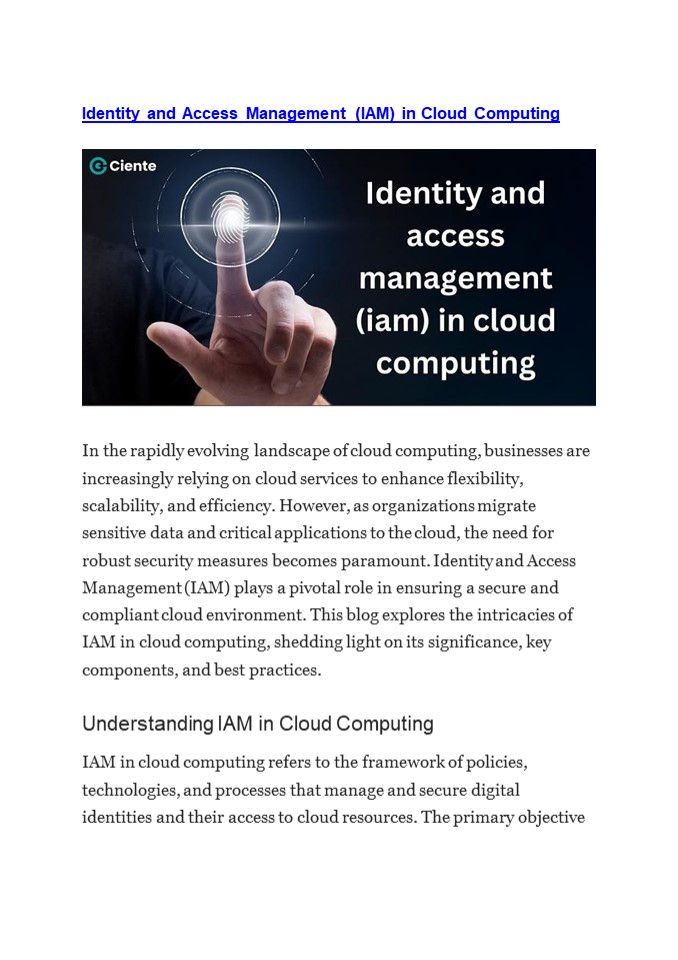Identity and Access Management (IAM) in Cloud Computing PowerPoint PPT Presentation
Title: Identity and Access Management (IAM) in Cloud Computing
1
Identity and Access Management (IAM) in Cloud
Computing
In the rapidly evolving landscape of cloud
computing, businesses are increasingly relying on
cloud services to enhance flexibility,
scalability, and efficiency. However, as
organizations migrate sensitive data and critical
applications to the cloud, the need for robust
security measures becomes paramount. Identity and
Access Management (IAM) plays a pivotal role in
ensuring a secure and compliant cloud
environment. This blog explores the intricacies
of IAM in cloud computing, shedding light on its
significance, key components, and best
practices. Understanding IAM in Cloud
Computing IAM in cloud computing refers to the
framework of policies, technologies, and
processes that manage and secure digital
identities and their access to cloud resources.
The primary objective
2
- is to ensure that only authorized individuals or
systems can access specific resources and that
they do so in a secure manner. - Key Components of IAM
- 1. Authentication
- Authentication is the process of verifying the
identity of users, devices, or systems attempting
to access cloud resources. - Multi-factor authentication (MFA) adds an extra
layer of security by requiring users to provide
multiple forms of identification. - Authorization
- Authorization determines the level of access
granted to authenticated entities. It involves
defining permissions and access controls based on
roles, groups, or individual users. - Role-based access control (RBAC) and
attribute-based access control (ABAC) are common
authorization models. - 3. Identity Lifecycle Management
- - IAM involves managing the entire lifecycle of
digital identities, from creation to deactivation.
3
- - Provisioning and de-provisioning mechanisms
automate the process of granting and revoking
access as employees join or leave the
organization. - Single Sign-On (SSO)
- SSO enables users to log in once and access
multiple applications or services without the
need to re-authenticate. - It enhances user experience and reduces the risk
associated with password-related vulnerabilities. - Audit and Compliance
- IAM systems include audit capabilities to track
user activities, changes in permissions, and
other relevant events. - Meeting compliance requirements, such as GDPR or
HIPAA, is critical for organizations handling
sensitive data. - Benefits of IAM in Cloud Computing
- 1. Enhanced Security IAM strengthens security by
ensuring that only authorized users have access
to specific resources. Multi- layered
authentication adds an extra barrier against
unauthorized access.
4
- Improved Compliance IAM helps organizations
adhere to regulatory requirements by implementing
access controls, auditing, and reporting
mechanisms. - Increased Operational Efficiency Automated
identity management processes streamline
onboarding, offboarding, and access requests,
reducing administrative overhead. - Risk Mitigation By enforcing least privilege
principles and regularly reviewing access
permissions, IAM helps mitigate the risk of data
breaches and insider threats. - Best Practices for Implementing IAM in Cloud
Computing - Define a Clear IAM Policy Clearly articulate
policies for user access, roles, and
responsibilities within the organization. - Regularly Review and Update Permissions Conduct
regular audits to review and update access
permissions, ensuring they align with business
needs. - Implement Strong Authentication Mechanisms
Utilize multi-factor authentication to enhance
the security of user logins. - Utilize RBAC and ABAC Implement role-based and
attribute- based access controls to manage
authorization effectively.
5
5. Monitor and Audit Activities Establish robust
monitoring and auditing mechanisms to track user
activities and detect anomalies. Conclusion As
organizations increasingly embrace cloud
computing, IAM emerges as a critical component in
ensuring a secure and well- managed cloud
environment. By adopting best practices and
leveraging the key components of IAM, businesses
can not only enhance security but also improve
operational efficiency, achieve compliance, and
mitigate risks associated with unauthorized
access. IAM, therefore, stands as a linchpin in
the overarching framework of cloud security,
facilitating a seamless and secure cloud
computing experience. AUTHOURS BIO With Ciente,
business leaders stay abreast of tech news and
market insights that help them level up
now, Technology spending is increasing, but so
is buyers remorse. We are here to change that.
Founded on truth, accuracy, and tech prowess,
Ciente is your go-to periodical for effective
decision-making. Our comprehensive editorial
coverage, market analysis, and tech insights
empower you to make smarter decisions to fuel
growth and innovation across your enterprise.
6
Let us help you navigate the rapidly evolving
world of technology and turn it to your advantage.

